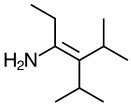8.1: Question 8.5.2.3 PASS - alkenes, label E or Z
- Page ID
- 452333
\( \newcommand{\vecs}[1]{\overset { \scriptstyle \rightharpoonup} {\mathbf{#1}} } \)
\( \newcommand{\vecd}[1]{\overset{-\!-\!\rightharpoonup}{\vphantom{a}\smash {#1}}} \)
\( \newcommand{\id}{\mathrm{id}}\) \( \newcommand{\Span}{\mathrm{span}}\)
( \newcommand{\kernel}{\mathrm{null}\,}\) \( \newcommand{\range}{\mathrm{range}\,}\)
\( \newcommand{\RealPart}{\mathrm{Re}}\) \( \newcommand{\ImaginaryPart}{\mathrm{Im}}\)
\( \newcommand{\Argument}{\mathrm{Arg}}\) \( \newcommand{\norm}[1]{\| #1 \|}\)
\( \newcommand{\inner}[2]{\langle #1, #2 \rangle}\)
\( \newcommand{\Span}{\mathrm{span}}\)
\( \newcommand{\id}{\mathrm{id}}\)
\( \newcommand{\Span}{\mathrm{span}}\)
\( \newcommand{\kernel}{\mathrm{null}\,}\)
\( \newcommand{\range}{\mathrm{range}\,}\)
\( \newcommand{\RealPart}{\mathrm{Re}}\)
\( \newcommand{\ImaginaryPart}{\mathrm{Im}}\)
\( \newcommand{\Argument}{\mathrm{Arg}}\)
\( \newcommand{\norm}[1]{\| #1 \|}\)
\( \newcommand{\inner}[2]{\langle #1, #2 \rangle}\)
\( \newcommand{\Span}{\mathrm{span}}\) \( \newcommand{\AA}{\unicode[.8,0]{x212B}}\)
\( \newcommand{\vectorA}[1]{\vec{#1}} % arrow\)
\( \newcommand{\vectorAt}[1]{\vec{\text{#1}}} % arrow\)
\( \newcommand{\vectorB}[1]{\overset { \scriptstyle \rightharpoonup} {\mathbf{#1}} } \)
\( \newcommand{\vectorC}[1]{\textbf{#1}} \)
\( \newcommand{\vectorD}[1]{\overrightarrow{#1}} \)
\( \newcommand{\vectorDt}[1]{\overrightarrow{\text{#1}}} \)
\( \newcommand{\vectE}[1]{\overset{-\!-\!\rightharpoonup}{\vphantom{a}\smash{\mathbf {#1}}}} \)
\( \newcommand{\vecs}[1]{\overset { \scriptstyle \rightharpoonup} {\mathbf{#1}} } \)
\( \newcommand{\vecd}[1]{\overset{-\!-\!\rightharpoonup}{\vphantom{a}\smash {#1}}} \)
\(\newcommand{\avec}{\mathbf a}\) \(\newcommand{\bvec}{\mathbf b}\) \(\newcommand{\cvec}{\mathbf c}\) \(\newcommand{\dvec}{\mathbf d}\) \(\newcommand{\dtil}{\widetilde{\mathbf d}}\) \(\newcommand{\evec}{\mathbf e}\) \(\newcommand{\fvec}{\mathbf f}\) \(\newcommand{\nvec}{\mathbf n}\) \(\newcommand{\pvec}{\mathbf p}\) \(\newcommand{\qvec}{\mathbf q}\) \(\newcommand{\svec}{\mathbf s}\) \(\newcommand{\tvec}{\mathbf t}\) \(\newcommand{\uvec}{\mathbf u}\) \(\newcommand{\vvec}{\mathbf v}\) \(\newcommand{\wvec}{\mathbf w}\) \(\newcommand{\xvec}{\mathbf x}\) \(\newcommand{\yvec}{\mathbf y}\) \(\newcommand{\zvec}{\mathbf z}\) \(\newcommand{\rvec}{\mathbf r}\) \(\newcommand{\mvec}{\mathbf m}\) \(\newcommand{\zerovec}{\mathbf 0}\) \(\newcommand{\onevec}{\mathbf 1}\) \(\newcommand{\real}{\mathbb R}\) \(\newcommand{\twovec}[2]{\left[\begin{array}{r}#1 \\ #2 \end{array}\right]}\) \(\newcommand{\ctwovec}[2]{\left[\begin{array}{c}#1 \\ #2 \end{array}\right]}\) \(\newcommand{\threevec}[3]{\left[\begin{array}{r}#1 \\ #2 \\ #3 \end{array}\right]}\) \(\newcommand{\cthreevec}[3]{\left[\begin{array}{c}#1 \\ #2 \\ #3 \end{array}\right]}\) \(\newcommand{\fourvec}[4]{\left[\begin{array}{r}#1 \\ #2 \\ #3 \\ #4 \end{array}\right]}\) \(\newcommand{\cfourvec}[4]{\left[\begin{array}{c}#1 \\ #2 \\ #3 \\ #4 \end{array}\right]}\) \(\newcommand{\fivevec}[5]{\left[\begin{array}{r}#1 \\ #2 \\ #3 \\ #4 \\ #5 \\ \end{array}\right]}\) \(\newcommand{\cfivevec}[5]{\left[\begin{array}{c}#1 \\ #2 \\ #3 \\ #4 \\ #5 \\ \end{array}\right]}\) \(\newcommand{\mattwo}[4]{\left[\begin{array}{rr}#1 \amp #2 \\ #3 \amp #4 \\ \end{array}\right]}\) \(\newcommand{\laspan}[1]{\text{Span}\{#1\}}\) \(\newcommand{\bcal}{\cal B}\) \(\newcommand{\ccal}{\cal C}\) \(\newcommand{\scal}{\cal S}\) \(\newcommand{\wcal}{\cal W}\) \(\newcommand{\ecal}{\cal E}\) \(\newcommand{\coords}[2]{\left\{#1\right\}_{#2}}\) \(\newcommand{\gray}[1]{\color{gray}{#1}}\) \(\newcommand{\lgray}[1]{\color{lightgray}{#1}}\) \(\newcommand{\rank}{\operatorname{rank}}\) \(\newcommand{\row}{\text{Row}}\) \(\newcommand{\col}{\text{Col}}\) \(\renewcommand{\row}{\text{Row}}\) \(\newcommand{\nul}{\text{Nul}}\) \(\newcommand{\var}{\text{Var}}\) \(\newcommand{\corr}{\text{corr}}\) \(\newcommand{\len}[1]{\left|#1\right|}\) \(\newcommand{\bbar}{\overline{\bvec}}\) \(\newcommand{\bhat}{\widehat{\bvec}}\) \(\newcommand{\bperp}{\bvec^\perp}\) \(\newcommand{\xhat}{\widehat{\xvec}}\) \(\newcommand{\vhat}{\widehat{\vvec}}\) \(\newcommand{\uhat}{\widehat{\uvec}}\) \(\newcommand{\what}{\widehat{\wvec}}\) \(\newcommand{\Sighat}{\widehat{\Sigma}}\) \(\newcommand{\lt}{<}\) \(\newcommand{\gt}{>}\) \(\newcommand{\amp}{&}\) \(\definecolor{fillinmathshade}{gray}{0.9}\)Label the following alkenes as E, Z, or neither
b) 
d) 
e) 
- Answers
-
b) E
d) Z
c) neither
- Strategy Map
-
Step Hint 1. Look to the left side of the double bond, using the laws for priority, identify if the substituent with the higher priority is on the top or bottom half of the double bond. Both substituents may have the same priority. 2. Repeat step one with the right side. 3. Identify if the higher priority substituents are both on one side or opposite sides of the double bond. Recall Z has high priority substiuents on same side, and E has high priority substituents on opposite sides (see LibreText 8.5.2 E/Z nomenclature)
- Solution
-
b) E (The substituents with higher priorities are on opposite sides)
d) Z (The substituents with higher priorities are on the same side)
e) neither (both substituents on the right have the same priority)
- Guided Solution
-
Download Guided Solution as a pdf
Guided Solution Hint This is a theory type problem where you must identify the geometry of alkene structures by labeling them E, Z or neither.
See LibreText 8.5.2 Sequence Rules - The E,Z Designation Label the following alkenes as E, Z, or neither
b)

d)

e)

Recall how to assign substituent priority:
First, determine the two substituents on each double-bonded carbon separately. Rank these substituents based on the atom which is directly attached to the double-bonded carbon. The substituent whose atom has a higher atomic number takes precedence over the substituent whose atom has a lower atomic number. If the atoms are the same, look to the next atom they are bonded to.
Recall rules for assigning priorities LibreText 8.4 Absolute Configuration (Sequence Rules to Assign Priorities to Substituents)
What does it mean for an alkene to have a type E geometry? If they have a type E geometry, the highest priority substituents are on opposite sides of the double bond (one is on the top and one is on the bottom). What does it mean for an alkene to have a type Z geometry? If they have a type Z geometry, the highest priority substituents are on the same side of the double bond (both on the top or both on the bottom). What does it mean if they have neither? If they have neither of these, that means that the substituents on one side (left or right) have the same priority. Complete Solution:
part b)

The priority substituents are highlighted in red, and the higher priorities are on opposite sides of the double bond.
answer E
part d)

The priority substituents are highlighted in red, and the higher priorities are on the same side of the double bond.
answer Z
part e)

Both of the substituents showing on the right side of the double bond above have the same priority, so it is neither E or Z.
answer neither
Check your work!
Go back and review your priority assignments to the double bond substituents. Make sure you go atom by atom when looking for priority.
Why does this answer make chemical sense?
The naming rules are used in order to fully describe the molecules when other naming systems do not work. Your answer should make sense if you are following all guidelines to identify priority and geometry.
See LibreText 8.5.2 Sequence Rules - The E,Z Designation (question source from page titled 7.6: Sequence Rules - The E,Z Designation https://chem.libretexts.org/Bookshelves/Organic_Chemistry/Organic_Chemistry_(Morsch_et_al.)/07%3A_Alkenes-_Structure_and_Reactivity/7.06%3A_Sequence_Rules_-_The_EZ_Designation, shared under a CC BY-SA 4.0 license, authored, remixed, and/or curated by Steven Farmer, Dietmar Kennepohl, Zachary Sharrett, Krista Cunningham, John Roberts, Marjorie C. Caserio & Robert Bruner)


